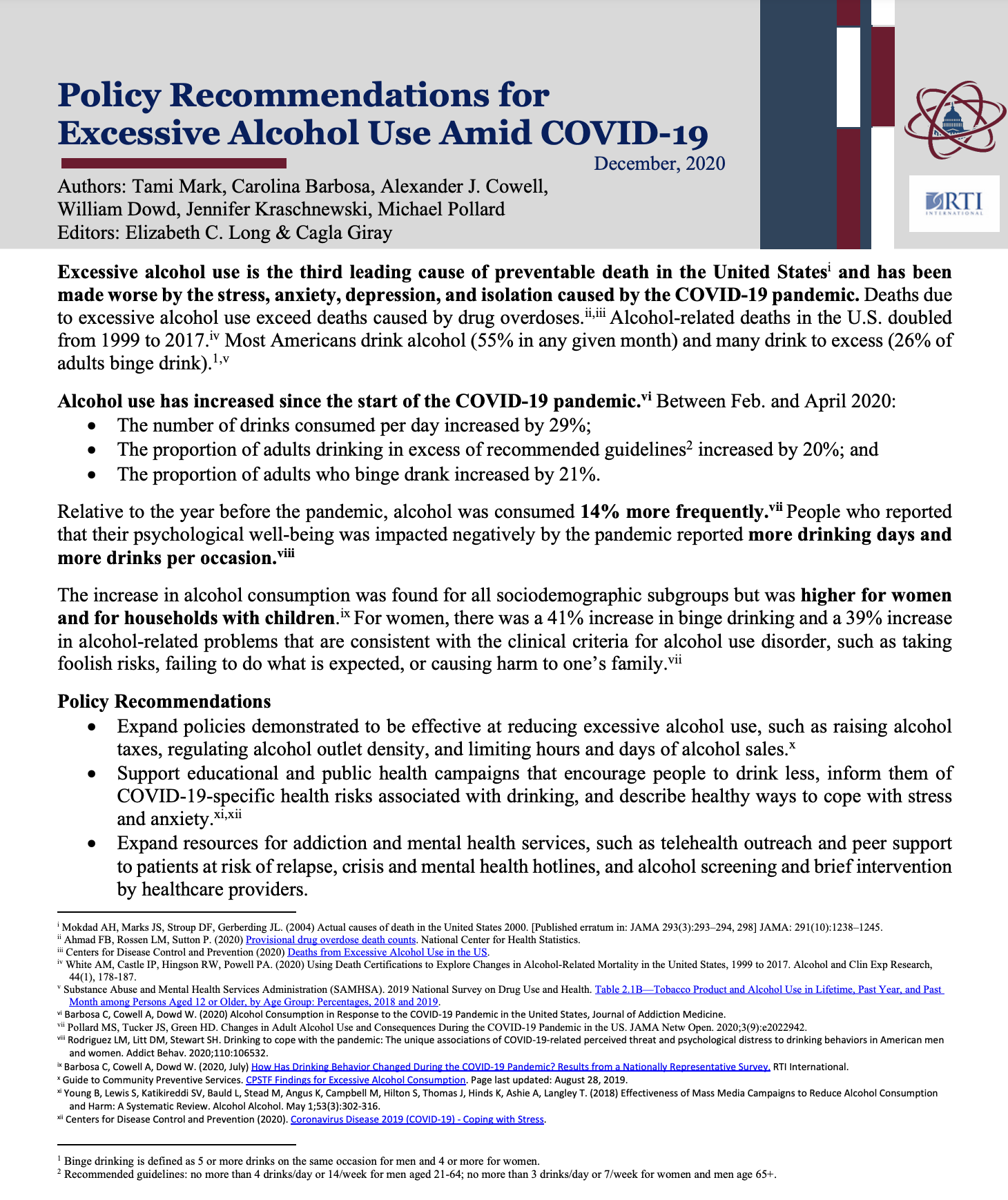

Excessive alcohol use is the third leading cause of preventable death in the United States[i] and has been made worse by the stress, anxiety, depression, and isolation caused by the COVID-19 pandemic. Deaths due to excessive alcohol use exceed deaths caused by drug overdoses.[ii],[iii] Alcohol-related deaths in the U.S. doubled from 1999 to 2017.[iv] Most Americans drink alcohol (55% in any given month) and many drink to excess (26% of adults binge drink).[1],[v]
Alcohol use has increased since the start of the COVID-19 pandemic.[vi] Between Feb. and April 2020:
- The number of drinks consumed per day increased by 29%;
- The proportion of adults drinking in excess of recommended guidelines[2] increased by 20%; and
- The proportion of adults who binge drank increased by 21%.
Relative to the year before the pandemic, alcohol was consumed 14% more frequently.[vii] People who reported that their psychological well-being was impacted negatively by the pandemic reported more drinking days and more drinks per occasion.[viii] The increase in alcohol consumption was found for all sociodemographic subgroups but was higher for women and for households with children.[ix] For women, there was a 41% increase in binge drinking and a 39% increase in alcohol-related problems that are consistent with the clinical criteria for alcohol use disorder, such as taking foolish risks, failing to do what is expected, or causing harm to one’s family.[vii]
Policy Recommendations
- Expand policies demonstrated to be effective at reducing excessive alcohol use, such as raising alcohol taxes, regulating alcohol outlet density, and limiting hours and days of alcohol sales.[x]
- Support educational and public health campaigns that encourage people to drink less, inform them of COVID-19-specific health risks associated with drinking, and describe healthy ways to cope with stress and anxiety.[xi],[xii]
- Expand resources for addiction and mental health services, such as telehealth outreach and peer support to patients at risk of relapse, crisis and mental health hotlines, and alcohol screening and brief intervention by healthcare providers.
End Notes / References
[i] Mokdad AH, Marks JS, Stroup DF, Gerberding JL. (2004) Actual causes of death in the United States 2000. [Published erratum in: JAMA 293(3):293–294, 298] JAMA: 291(10):1238–1245.
[ii] Ahmad FB, Rossen LM, Sutton P. (2020) Provisional drug overdose death counts. National Center for Health Statistics.
[iii] Centers for Disease Control and Prevention (2020) Deaths from Excessive Alcohol Use in the US.
[iv] White AM, Castle IP, Hingson RW, Powell PA. (2020) Using Death Certifications to Explore Changes in Alcohol-Related Mortality in the United States, 1999 to 2017. Alcohol and Clin Exp Research, 44(1), 178-187.
[v] Substance Abuse and Mental Health Services Administration (SAMHSA). 2019 National Survey on Drug Use and Health. Table 2.1B—Tobacco Product and Alcohol Use in Lifetime, Past Year, and Past Month among Persons Aged 12 or Older, by Age Group: Percentages, 2018 and 2019.
[vi] Barbosa C, Cowell A, Dowd W. (2020) Alcohol Consumption in Response to the COVID-19 Pandemic in the United States, Journal of Addiction Medicine.
[vii] Pollard MS, Tucker JS, Green HD. Changes in Adult Alcohol Use and Consequences During the COVID-19 Pandemic in the US. JAMA Netw Open. 2020;3(9):e2022942.
[viii] Rodriguez LM, Litt DM, Stewart SH. Drinking to cope with the pandemic: The unique associations of COVID-19-related perceived threat and psychological distress to drinking behaviors in American men and women. Addict Behav. 2020;110:106532.
[ix] Barbosa C, Cowell A, Dowd W. (2020, July) How Has Drinking Behavior Changed During the COVID-19 Pandemic? Results from a Nationally Representative Survey. RTI International.
[x] Guide to Community Preventive Services. CPSTF Findings for Excessive Alcohol Consumption. Page last updated: August 28, 2019.
[xi] Young B, Lewis S, Katikireddi SV, Bauld L, Stead M, Angus K, Campbell M, Hilton S, Thomas J, Hinds K, Ashie A, Langley T. (2018) Effectiveness of Mass Media Campaigns to Reduce Alcohol Consumption and Harm: A Systematic Review. Alcohol Alcohol. May 1;53(3):302-316.
[xii] Centers for Disease Control and Prevention (2020). Coronavirus Disease 2019 (COVID-19) – Coping with Stress.
[1] Binge drinking is defined as 5 or more drinks on the same occasion for men and 4 or more for women.
[2] Recommended guidelines: no more than 4 drinks/day or 14/week for men aged 21-64; no more than 3 drinks/day or 7/week for women and men age 65+.
The Research-to-Policy Collaboration (RPC) works to bring together research professionals and public officials to support evidence-based policy. Please visit their website to learn more.
Key Information
RPC Website
Research-to-Policy Collaboration
Publication DateDecember 1, 2020
Topic Area(s)Health, Substance Use and Misuse
Resource TypeWritten Briefs
Share This Page

Excessive alcohol use is the third leading cause of preventable death in the United States[i] and has been made worse by the stress, anxiety, depression, and isolation caused by the COVID-19 pandemic. Deaths due to excessive alcohol use exceed deaths caused by drug overdoses.[ii],[iii] Alcohol-related deaths in the U.S. doubled from 1999 to 2017.[iv] Most Americans drink alcohol (55% in any given month) and many drink to excess (26% of adults binge drink).[1],[v]
Alcohol use has increased since the start of the COVID-19 pandemic.[vi] Between Feb. and April 2020:
- The number of drinks consumed per day increased by 29%;
- The proportion of adults drinking in excess of recommended guidelines[2] increased by 20%; and
- The proportion of adults who binge drank increased by 21%.
Relative to the year before the pandemic, alcohol was consumed 14% more frequently.[vii] People who reported that their psychological well-being was impacted negatively by the pandemic reported more drinking days and more drinks per occasion.[viii] The increase in alcohol consumption was found for all sociodemographic subgroups but was higher for women and for households with children.[ix] For women, there was a 41% increase in binge drinking and a 39% increase in alcohol-related problems that are consistent with the clinical criteria for alcohol use disorder, such as taking foolish risks, failing to do what is expected, or causing harm to one’s family.[vii]
Policy Recommendations
- Expand policies demonstrated to be effective at reducing excessive alcohol use, such as raising alcohol taxes, regulating alcohol outlet density, and limiting hours and days of alcohol sales.[x]
- Support educational and public health campaigns that encourage people to drink less, inform them of COVID-19-specific health risks associated with drinking, and describe healthy ways to cope with stress and anxiety.[xi],[xii]
- Expand resources for addiction and mental health services, such as telehealth outreach and peer support to patients at risk of relapse, crisis and mental health hotlines, and alcohol screening and brief intervention by healthcare providers.
End Notes / References
[i] Mokdad AH, Marks JS, Stroup DF, Gerberding JL. (2004) Actual causes of death in the United States 2000. [Published erratum in: JAMA 293(3):293–294, 298] JAMA: 291(10):1238–1245.
[ii] Ahmad FB, Rossen LM, Sutton P. (2020) Provisional drug overdose death counts. National Center for Health Statistics.
[iii] Centers for Disease Control and Prevention (2020) Deaths from Excessive Alcohol Use in the US.
[iv] White AM, Castle IP, Hingson RW, Powell PA. (2020) Using Death Certifications to Explore Changes in Alcohol-Related Mortality in the United States, 1999 to 2017. Alcohol and Clin Exp Research, 44(1), 178-187.
[v] Substance Abuse and Mental Health Services Administration (SAMHSA). 2019 National Survey on Drug Use and Health. Table 2.1B—Tobacco Product and Alcohol Use in Lifetime, Past Year, and Past Month among Persons Aged 12 or Older, by Age Group: Percentages, 2018 and 2019.
[vi] Barbosa C, Cowell A, Dowd W. (2020) Alcohol Consumption in Response to the COVID-19 Pandemic in the United States, Journal of Addiction Medicine.
[vii] Pollard MS, Tucker JS, Green HD. Changes in Adult Alcohol Use and Consequences During the COVID-19 Pandemic in the US. JAMA Netw Open. 2020;3(9):e2022942.
[viii] Rodriguez LM, Litt DM, Stewart SH. Drinking to cope with the pandemic: The unique associations of COVID-19-related perceived threat and psychological distress to drinking behaviors in American men and women. Addict Behav. 2020;110:106532.
[ix] Barbosa C, Cowell A, Dowd W. (2020, July) How Has Drinking Behavior Changed During the COVID-19 Pandemic? Results from a Nationally Representative Survey. RTI International.
[x] Guide to Community Preventive Services. CPSTF Findings for Excessive Alcohol Consumption. Page last updated: August 28, 2019.
[xi] Young B, Lewis S, Katikireddi SV, Bauld L, Stead M, Angus K, Campbell M, Hilton S, Thomas J, Hinds K, Ashie A, Langley T. (2018) Effectiveness of Mass Media Campaigns to Reduce Alcohol Consumption and Harm: A Systematic Review. Alcohol Alcohol. May 1;53(3):302-316.
[xii] Centers for Disease Control and Prevention (2020). Coronavirus Disease 2019 (COVID-19) – Coping with Stress.
[1] Binge drinking is defined as 5 or more drinks on the same occasion for men and 4 or more for women.
[2] Recommended guidelines: no more than 4 drinks/day or 14/week for men aged 21-64; no more than 3 drinks/day or 7/week for women and men age 65+.
The Research-to-Policy Collaboration (RPC) works to bring together research professionals and public officials to support evidence-based policy. Please visit their website to learn more.

Key Information
RPC Website
Research-to-Policy Collaboration
Publication DateDecember 1, 2020
Topic Area(s)Health, Substance Use and Misuse
Resource TypeWritten Briefs
Share This Page
LET’S STAY IN TOUCH
Join the Evidence-to-Impact Mailing List
Keep up to date with the latest resources, events, and news from the EIC.




